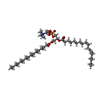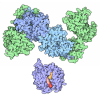+ Open data
Open data
- Basic information
Basic information
| Entry |  | |||||||||
|---|---|---|---|---|---|---|---|---|---|---|
| Title | LGTV TP21. Langat virus, strain TP21 | |||||||||
 Map data Map data | Sharpened with deepEMchancer. | |||||||||
 Sample Sample |
| |||||||||
 Keywords Keywords | Flavivirus / Langat virus / recombinant virus / VIRUS | |||||||||
| Function / homology |  Function and homology information Function and homology informationsymbiont-mediated suppression of host JAK-STAT cascade via inhibition of JAK1 activity / flavivirin / symbiont-mediated suppression of host JAK-STAT cascade via inhibition of host TYK2 activity / symbiont-mediated suppression of host JAK-STAT cascade via inhibition of STAT2 activity / symbiont-mediated suppression of host JAK-STAT cascade via inhibition of STAT1 activity / symbiont-mediated activation of host apoptosis / viral capsid / double-stranded RNA binding / nucleoside-triphosphate phosphatase / clathrin-dependent endocytosis of virus by host cell ...symbiont-mediated suppression of host JAK-STAT cascade via inhibition of JAK1 activity / flavivirin / symbiont-mediated suppression of host JAK-STAT cascade via inhibition of host TYK2 activity / symbiont-mediated suppression of host JAK-STAT cascade via inhibition of STAT2 activity / symbiont-mediated suppression of host JAK-STAT cascade via inhibition of STAT1 activity / symbiont-mediated activation of host apoptosis / viral capsid / double-stranded RNA binding / nucleoside-triphosphate phosphatase / clathrin-dependent endocytosis of virus by host cell / mRNA (guanine-N7)-methyltransferase / methyltransferase cap1 / methyltransferase cap1 activity / mRNA 5'-cap (guanine-N7-)-methyltransferase activity / RNA helicase activity / protein dimerization activity / host cell perinuclear region of cytoplasm / host cell endoplasmic reticulum membrane / RNA helicase / symbiont-mediated suppression of host type I interferon-mediated signaling pathway / symbiont-mediated activation of host autophagy / RNA-directed RNA polymerase / serine-type endopeptidase activity / viral RNA genome replication / RNA-directed RNA polymerase activity / fusion of virus membrane with host endosome membrane / viral envelope / virion attachment to host cell / host cell nucleus / virion membrane / structural molecule activity / ATP hydrolysis activity / proteolysis / extracellular region / ATP binding / metal ion binding / membrane Similarity search - Function | |||||||||
| Biological species |  Langat virus (strain TP21) Langat virus (strain TP21) | |||||||||
| Method | single particle reconstruction / cryo EM / Resolution: 3.82 Å | |||||||||
 Authors Authors | Bisikalo K / Rosendal E | |||||||||
| Funding support |  Sweden, 1 items Sweden, 1 items
| |||||||||
 Citation Citation |  Journal: J Virol / Year: 2025 Journal: J Virol / Year: 2025Title: Influence of the pre-membrane and envelope proteins on structure, pathogenicity, and tropism of tick-borne encephalitis virus. Authors: Ebba Rosendal / Kyrylo Bisikalo / Stefanie M A Willekens / Marie Lindgren / Jiří Holoubek / Pavel Svoboda / Amanda Lappalainen / Ebba Könighofer / Ekaterina Mirgorodskaya / Rickard ...Authors: Ebba Rosendal / Kyrylo Bisikalo / Stefanie M A Willekens / Marie Lindgren / Jiří Holoubek / Pavel Svoboda / Amanda Lappalainen / Ebba Könighofer / Ekaterina Mirgorodskaya / Rickard Nordén / Federico Morini / William Rosenbaum / Daniel Růžek / Ulf Ahlgren / Maria Anastasina / Andres Merits / Sarah J Butcher / Emma Nilsson / Anna K Överby /      Abstract: Tick-borne encephalitis virus (TBEV) is a neurotropic flavivirus that causes thousands of human infections annually. Viral tropism in the brain is determined by the presence of necessary receptors, ...Tick-borne encephalitis virus (TBEV) is a neurotropic flavivirus that causes thousands of human infections annually. Viral tropism in the brain is determined by the presence of necessary receptors, entry factors, and the ability of the virus to overcome host defenses. The viral structural proteins, pre-membrane (prM), and envelope (E) play an important role in receptor binding, membrane fusion, particle maturation, and antibody neutralization. To understand how these proteins influence virus distribution and tropism in the brain, we generated a chimeric virus harboring the prM and ectodomain of E from TBEV in the background of the low-pathogenic Langat virus (LGTV). We solved the atomic structures of both the chimeric virus and LGTV to compare them to the known TBEV structure. We show that this chimeric virus remains low-pathogenic, while being structurally and antigenically similar to TBEV. Using 3D optical whole brain imaging combined with immunohistochemistry, we found that both LGTV and the chimeric virus primarily infect the cerebral cortex, with no significant differences in their localization or tropism. In contrast, TBEV shows high infection of the cerebellum and a strong preference toward Purkinje cells, indicating that factors other than the prM and E proteins are important for determining TBEV tropism in the brain. Together, this provides new insights into the roles of the structural and non-structural proteins of tick-borne flaviviruses. IMPORTANCE: Although an effective vaccine exists, there is no treatment for those infected by the tick-borne encephalitis virus (TBEV). This study aimed to better understand how the virus's surface ...IMPORTANCE: Although an effective vaccine exists, there is no treatment for those infected by the tick-borne encephalitis virus (TBEV). This study aimed to better understand how the virus's surface proteins influence viral tropism and pathogenicity. We created a chimeric virus with prM and E proteins of TBEV in the genetic background of the low-pathogenic Langat virus (LGTV). The chimeric virus remained low pathogenic, similar to LGTV. Both viruses infected similar brain regions, while TBEV showed a strong preference for the cerebellum and Purkinje cells. This means that other parts of the virus, such as non-structural proteins or NCR, likely decide how the virus behaves in the brain. This study also presents the first cryogenic electron microscopy structure of LGTV, the first whole-brain imaging of TBEV infection in mouse brain, and a new model system to study surface proteins in tick-borne flaviviruses-laying groundwork for future studies on viral tropism, antibody cross-reactivity, and virus-receptor interaction. #1:  Journal: Biorxiv / Year: 2024 Journal: Biorxiv / Year: 2024Title: The influence of the pre-membrane and envelope proteins on structure, pathogenicity and tropism of tick-borne encephalitis virus Authors: Rosendal E / Bisikalo K / Willekens SM / Lindgren M / Holoubek J / Svoboda P / Lappalainen A / Konighofer E / Mirgorodskaya E / Norden R / Morini F / Rosenbaum W / Ruzek D / Ahlgren U / ...Authors: Rosendal E / Bisikalo K / Willekens SM / Lindgren M / Holoubek J / Svoboda P / Lappalainen A / Konighofer E / Mirgorodskaya E / Norden R / Morini F / Rosenbaum W / Ruzek D / Ahlgren U / Anastasina M / Merits A / Butcher SJ / Nilsson E / Overby AK | |||||||||
| History |
|
- Structure visualization
Structure visualization
| Supplemental images |
|---|
- Downloads & links
Downloads & links
-EMDB archive
| Map data |  emd_50624.map.gz emd_50624.map.gz | 1.5 GB |  EMDB map data format EMDB map data format | |
|---|---|---|---|---|
| Header (meta data) |  emd-50624-v30.xml emd-50624-v30.xml emd-50624.xml emd-50624.xml | 31.3 KB 31.3 KB | Display Display |  EMDB header EMDB header |
| FSC (resolution estimation) |  emd_50624_fsc.xml emd_50624_fsc.xml | 25.1 KB | Display |  FSC data file FSC data file |
| Images |  emd_50624.png emd_50624.png | 76.4 KB | ||
| Filedesc metadata |  emd-50624.cif.gz emd-50624.cif.gz | 8.2 KB | ||
| Others |  emd_50624_half_map_1.map.gz emd_50624_half_map_1.map.gz emd_50624_half_map_2.map.gz emd_50624_half_map_2.map.gz | 1.5 GB 1.5 GB | ||
| Archive directory |  http://ftp.pdbj.org/pub/emdb/structures/EMD-50624 http://ftp.pdbj.org/pub/emdb/structures/EMD-50624 ftp://ftp.pdbj.org/pub/emdb/structures/EMD-50624 ftp://ftp.pdbj.org/pub/emdb/structures/EMD-50624 | HTTPS FTP |
-Validation report
| Summary document |  emd_50624_validation.pdf.gz emd_50624_validation.pdf.gz | 1.2 MB | Display |  EMDB validaton report EMDB validaton report |
|---|---|---|---|---|
| Full document |  emd_50624_full_validation.pdf.gz emd_50624_full_validation.pdf.gz | 1.1 MB | Display | |
| Data in XML |  emd_50624_validation.xml.gz emd_50624_validation.xml.gz | 36 KB | Display | |
| Data in CIF |  emd_50624_validation.cif.gz emd_50624_validation.cif.gz | 47.1 KB | Display | |
| Arichive directory |  https://ftp.pdbj.org/pub/emdb/validation_reports/EMD-50624 https://ftp.pdbj.org/pub/emdb/validation_reports/EMD-50624 ftp://ftp.pdbj.org/pub/emdb/validation_reports/EMD-50624 ftp://ftp.pdbj.org/pub/emdb/validation_reports/EMD-50624 | HTTPS FTP |
-Related structure data
| Related structure data |  9fojMC  9fk0C  9h28C M: atomic model generated by this map C: citing same article ( |
|---|---|
| Similar structure data | Similarity search - Function & homology  F&H Search F&H Search |
- Links
Links
| EMDB pages |  EMDB (EBI/PDBe) / EMDB (EBI/PDBe) /  EMDataResource EMDataResource |
|---|---|
| Related items in Molecule of the Month |
- Map
Map
| File |  Download / File: emd_50624.map.gz / Format: CCP4 / Size: 1.6 GB / Type: IMAGE STORED AS FLOATING POINT NUMBER (4 BYTES) Download / File: emd_50624.map.gz / Format: CCP4 / Size: 1.6 GB / Type: IMAGE STORED AS FLOATING POINT NUMBER (4 BYTES) | ||||||||||||||||||||||||||||||||||||
|---|---|---|---|---|---|---|---|---|---|---|---|---|---|---|---|---|---|---|---|---|---|---|---|---|---|---|---|---|---|---|---|---|---|---|---|---|---|
| Annotation | Sharpened with deepEMchancer. | ||||||||||||||||||||||||||||||||||||
| Projections & slices | Image control
Images are generated by Spider. | ||||||||||||||||||||||||||||||||||||
| Voxel size | X=Y=Z: 0.97 Å | ||||||||||||||||||||||||||||||||||||
| Density |
| ||||||||||||||||||||||||||||||||||||
| Symmetry | Space group: 1 | ||||||||||||||||||||||||||||||||||||
| Details | EMDB XML:
|
-Supplemental data
-Half map: #2
| File | emd_50624_half_map_1.map | ||||||||||||
|---|---|---|---|---|---|---|---|---|---|---|---|---|---|
| Projections & Slices |
| ||||||||||||
| Density Histograms |
-Half map: #1
| File | emd_50624_half_map_2.map | ||||||||||||
|---|---|---|---|---|---|---|---|---|---|---|---|---|---|
| Projections & Slices |
| ||||||||||||
| Density Histograms |
- Sample components
Sample components
-Entire : Langat virus (strain TP21)
| Entire | Name:  Langat virus (strain TP21) Langat virus (strain TP21) |
|---|---|
| Components |
|
-Supramolecule #1: Langat virus (strain TP21)
| Supramolecule | Name: Langat virus (strain TP21) / type: virus / ID: 1 / Parent: 0 / Macromolecule list: #1-#2 / NCBI-ID: 31638 / Sci species name: Langat virus (strain TP21) / Virus type: VIRION / Virus isolate: STRAIN / Virus enveloped: Yes / Virus empty: No |
|---|---|
| Virus shell | Shell ID: 1 / Diameter: 500.0 Å / T number (triangulation number): 3 |
-Macromolecule #1: Envelope protein E
| Macromolecule | Name: Envelope protein E / type: protein_or_peptide / ID: 1 / Number of copies: 3 / Enantiomer: LEVO |
|---|---|
| Source (natural) | Organism:  Langat virus (strain TP21) Langat virus (strain TP21) |
| Molecular weight | Theoretical: 53.574301 KDa |
| Recombinant expression | Organism:  Homo sapiens (human) Homo sapiens (human) |
| Sequence | String: SRCTHLENRD FVTGVQGTTR LTLVLELGGC VTVTADGKPS LDVWLDSIYQ ESPAQTREYC LHAKLTGTKV AARCPTMGPA TLPEEHQSG TVCKRDQSDR GWGNHCGLFG KGSIVTCVKF TCEDKKKATG HVYDVNKITY TIKVEPHTGE FVAANETHSG R KSASFTVS ...String: SRCTHLENRD FVTGVQGTTR LTLVLELGGC VTVTADGKPS LDVWLDSIYQ ESPAQTREYC LHAKLTGTKV AARCPTMGPA TLPEEHQSG TVCKRDQSDR GWGNHCGLFG KGSIVTCVKF TCEDKKKATG HVYDVNKITY TIKVEPHTGE FVAANETHSG R KSASFTVS SEKTILTLGD YGDVSLLCRV ASGVDLAQTV VLALDKTHEH LPTAWQVHRD WFNDLALPWK HDGAEAWNEA GR LVEFGTP HAVKMDVFNL GDQTGVLLKS LAGVPVASIE GTKYHLKSGH VTCEVGLEKL KMKGLTYTVC DKTKFTWKRA PTD SGHDTV VMEVGFSGTR PCRIPVRAVA HGVPEVNVAM LITPNPTMEN NGGGFIEMQL PPGDNIIYVG DLNHQWFQKG SSIG RVLQK TRKGIERLTV LGEHAWDFGS VGGVMTSIGR AMHTVLGGAF NTLLGGVGFL PKILLGVAMA WLGLNMRNPT LSMGF LLSG GLVLAMTLGV GA UniProtKB: Genome polyprotein |
-Macromolecule #2: Small envelope protein M
| Macromolecule | Name: Small envelope protein M / type: protein_or_peptide / ID: 2 / Number of copies: 3 / Enantiomer: LEVO |
|---|---|
| Source (natural) | Organism:  Langat virus (strain TP21) Langat virus (strain TP21) |
| Molecular weight | Theoretical: 8.249828 KDa |
| Recombinant expression | Organism:  Homo sapiens (human) Homo sapiens (human) |
| Sequence | String: VLIPSHAQRD LTGRGHQWLE GEAVKAHLTR VEGWVWKNKL FTLSLVMVAW LMVDGLLPRI LIVVVALALA PAYA UniProtKB: Genome polyprotein |
-Macromolecule #4: 1-PALMITOYL-2-LINOLEOYL-SN-GLYCERO-3-PHOSPHOCHOLINE
| Macromolecule | Name: 1-PALMITOYL-2-LINOLEOYL-SN-GLYCERO-3-PHOSPHOCHOLINE / type: ligand / ID: 4 / Number of copies: 6 / Formula: CPL |
|---|---|
| Molecular weight | Theoretical: 758.06 Da |
| Chemical component information |  ChemComp-CPL: |
-Experimental details
-Structure determination
| Method | cryo EM |
|---|---|
 Processing Processing | single particle reconstruction |
| Aggregation state | particle |
- Sample preparation
Sample preparation
| Buffer | pH: 8 Details: VP-SFM growth medium, supplemented with rapamycin and glutamate. |
|---|---|
| Grid | Model: Quantifoil R1.2/1.3 / Material: COPPER / Mesh: 300 / Support film - Material: CARBON / Support film - topology: CONTINUOUS / Support film - Film thickness: 2 / Pretreatment - Type: GLOW DISCHARGE / Pretreatment - Time: 15 sec. / Pretreatment - Atmosphere: OTHER |
| Vitrification | Cryogen name: ETHANE / Instrument: LEICA EM GP |
- Electron microscopy
Electron microscopy
| Microscope | FEI TALOS ARCTICA |
|---|---|
| Image recording | Film or detector model: FEI FALCON III (4k x 4k) / Detector mode: COUNTING / Number grids imaged: 1 / Number real images: 1430 / Average electron dose: 40.0 e/Å2 |
| Electron beam | Acceleration voltage: 200 kV / Electron source:  FIELD EMISSION GUN FIELD EMISSION GUN |
| Electron optics | Illumination mode: FLOOD BEAM / Imaging mode: BRIGHT FIELD / Nominal defocus max: 1.6 µm / Nominal defocus min: 0.6 µm / Nominal magnification: 150000 |
| Experimental equipment |  Model: Talos Arctica / Image courtesy: FEI Company |
+ Image processing
Image processing
-Atomic model buiding 1
| Initial model | Chain - Source name: AlphaFold / Chain - Initial model type: in silico model |
|---|---|
| Refinement | Space: REAL / Protocol: FLEXIBLE FIT |
| Output model |  PDB-9foj: |
 Movie
Movie Controller
Controller








 Z (Sec.)
Z (Sec.) Y (Row.)
Y (Row.) X (Col.)
X (Col.)





































